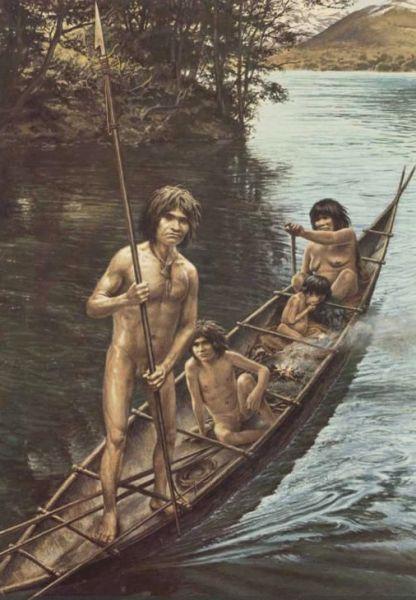
Proto/Paleo-Indians: Early Sites

Figure 1.--A generation ago, the story of the peopleing of the America was thought to have been well understood. The Bearing Sea Crossing, an Ice Age corrdidor and Clovis First. Today most of this elegant theory is in shreads. The earliest evidence of Proto-Indians outside of Beringia has been found not in North America, bit in of all places southern South America--Monte Verde in the Chilean Lake District. And year by year, new early sites have been turning up in both South America and eastern North America. This is a Chilean artists conception of the early proto-Indians in Chile. Source: Biblioteca Nacional de Chile (MC0004334).
|
|
Proto-Indians are, to say the least, not well understood. There are a range of issues. By far the most important is that very old sites have been found not in North Anerica, but in South America, For years it waa thought that the Clovis people were the first people the migrate south from Beringa and penetrate into the heart of North America. We know now that this was not the case. W now know of several archeolical sites in both North and South America that predate earlier estimates of not only the Clovis people, but what had been accepted as the approximate date of the earliest Bearing Sea crossing. The earliest at this time appears to be in of all places Monte Verde in the Lake District of southern Chile. No one expected the earliest site would be found in the south of South America It just did not fit in with a Bearing Sea crossing. There are very wide ranges in the dating of the Bearing Sea crossing and the appearance of Proto-Indians in different localities. Some academics claim that Proto-Indians may have appeard as early as 40,000-45,000 years ago--although this early date is stiill the matter of considerable controversy . The problem with dating Proto-Indians is that often the only archeological evidence are only the stone tools which can not be carbon dated. Sometimes there are materials lovated in an ariound the tools that have been found, but that is not the same as dating the tools. Several early sites have been found in both North Amd South America. Many of these sites have been questioned, but Monte Verde has been throughly vetted by several archeologists, at least MVI. Although archeologists are concerned that thee are no similar sites in the vicinity. The dating of MVII is still in question. Another issue that has caused considerable turmoil is pottery. In pre-DNA days, cermaics (pottery) was widely used by archeologists to identify and date civilizations and track the movements of peoples. Pottery goes hand-in-hand with civilizations. It is to heavy for nomadic people to transport. And it requirs a degree of technological achievement. The earliest trace of pottery has been found in the Amazonian Basin. Pottery from the lower Amazon Basin (the Caverna de Pedra Pintada) near Santarém, Brazil, have been dated to 5,000-7,500 years ago. Again, this is not what archeologists expected. Most would have guessed Meso-America. In fact, until very recently, it was believed that the Amazon had been inhabited by primitive peoples with no important cultural achievements. It is veru clear that new theories are needed concerning the peopleing of the Americas.
HBC

Navigate the Historic Boys' Clothing Web Site:
[Return to the Main proto-Indian page]
[Return to the Main Native American Ice Age Migrations page ]
[Return to the Main Native American page]
[Introduction]
[Activities]
[Biographies]
[Chronology]
[Clothing styles]
[Countries]
[Bibliographies]
[Contributions]
[Essays]
[FAQs]
[Glossaries]
[Images]
[Links]
[Registration]
[Tools]
[Boys' Clothing Home]
Created: 5:13 PM 12/28/2013
Last updated: 4:47 PM 12/28/2013



